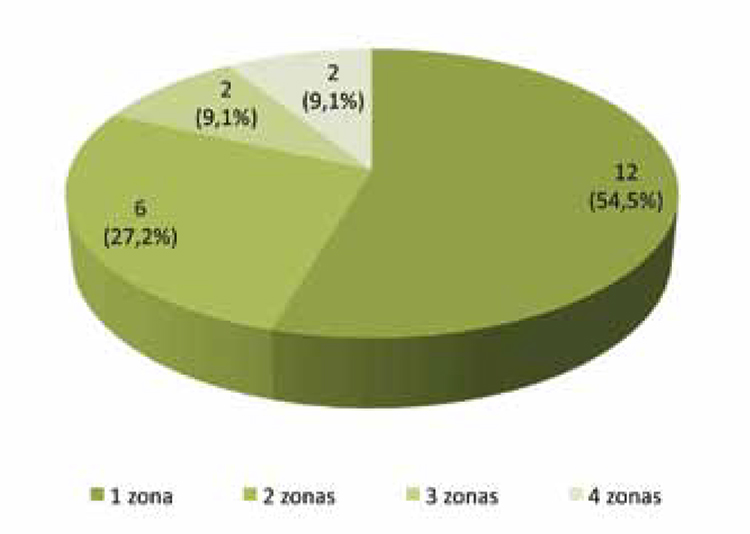Treatment during a year with 0.1% tacrolimus ointment in young patients with vitiligo
Keywords:
vitiligo, skin, tacrolimusAbstract
Background: Vitiligo is a skin disorder with a predominant autoimmune etiology, characterized by depigmentation of skin and hair. In children, this condition becomes a serious esthetic problem, as well as a therapeutic challenge, due to frequent adverse reactions caused by standard treatments (phototherapy and corticosteroids).
Methods: A retrospective study was carried out at the Pediatric Dermatological Unit of La Paz Hospital, with patients treated between 2002 and 2008. Response after one year of treatment with topical tacrolimus 0.1% ointment in 22 young patients (2 to 16 year-old) diagnosed of vitiligo, was assessed.
Results: Some degree of repigmentation was observed in 81.8% of patients. A statistical analysis showed that significant response was observed in face, neck and extremities after 9 months of treatment, while in the trunk improvement occurred after 12 months. No related adverse reactions were observed during the treatment period.
Conclusion: Tacrolimus ointment could be a good therapeutic option in pediatric patients affected with vitiligo.
Author Biographies
Rosa Feltes
Servicio de Dermatología, Hospital Universitario La Paz, Madrid, España
Uxúa Floristán
Servicio de Dermatología, Hospital Universitario La Paz, Madrid, España
Elena Sendagorta
Servicio de Dermatología, Hospital Universitario La Paz, Madrid, España
Paloma Ramírez
Servicio de Dermatología, Hospital Universitario La Paz, Madrid, España
Jesús Diez-Sebastian
Unidad de Bioestadística, Hospital Universitario La Paz, Madrid, España
Raúl De Lucas Laguna
Servicio de Dermatología, Hospital Universitario La Paz, Madrid, España
References
2. Taïeb A, Picardo M. Clinical practice. Vitiligo. N Engl J Med. 2009;8:160-9.
3. Whitton ME, Ashcroft DM, González U. Therapeutic interventions for vitiligo. J Am Acad Dermatol. 2008;59:713-7.
4. Gawkrodger DJ, Ormerod AD, Shaw L, Mauri-Sole I, Whitton ME, Watts MJ, et al. Guideline for the diagnosis and management of vitiligo. Br J Dermatol. 2008;159:1051-76.
5. Allison AC. Immunosuppressive drugs: The first 50 years and a glance forward. Immunopharmacology. 2000;47:63-83.
6. Grimes PE, Soriano T, Dytoc MT. Topical tacrolimus for repigmentation of vitiligo. J Am Acad Dermatol. 2002;47:789-91.
7. Smith DA, Tofte SJ, Hanifin JM. Repigmentation of vitiligo with topical tacrolimus. Dermatology. 2002;205:301-3.
8. Woo DK, James WD. Topical tacrolimus: A review of its uses in dermatology. Dermatitis. 2005;16:6-21.
9. Tanghetti EA. Tacrolimus ointment 0.1% produces repigmentation in patients with vitiligo: Results of a prospective patient series. Cutis. 2003;71:158-62.
10. Silverberg NB, Lin P, Travis L, Farley-Li J, Mancini AJ, Wagner AM, et al. Tacrolimus ointment promotes repigmentation of vitiligo in children: A review of 57 cases. J Am Acad Dermatol. 2004;51:760-6.
11. Lepe V, Moncada B, Castanedo-Cazares JP, Torres-Álvarez MB, Ortiz CA, Torres-Rubalcava AB. A double-blind randomized trial of 0.1% tacrolimus Vs. 0.05% clobetasol for the treatment of childhood vitiligo. Arch Dermatol. 2003;139:581-5.
12. Choi CW, Chang SE, Bak H, Choi JH, Park HS, Huh CH, et al. Topical immunomodulators are effective for treatment of vitiligo. J Dermatol. 2008;35:503-7.
13. Kanwar AJ, Dogra S, Parsad D. Topical tacrolimus for treatment of childhood vitiligo in Asians. Clin Exp Dermatol. 2004;29:589-92.
14. Zabawski EJ, Costner M, Cohen JB, Cockerell CJ. Tacrolimus: Pharmacology and therapeutic uses in dermatology. Int J Dermatol. 2000;39:721-7.
15. Skaehill PA. Tacrolimus in dermatologic disorders. Ann Pharmacother. 2001;35:582-8.
16. Agencia Europea del Medicamento. Protopic. Ficha técnica. Fecha de consulta: 8 de agosto de 2009. Disponible en: http:// www.emea.europa.eu/humandocs/ PDFs/ EPAR/protopic
17. Kang HY, Choi YM. FK506 increases pigmentation and migration of human melanocytes. Br J Dermatol. 2006;155:1037-40.
18. Lan CC, Chen GS, Chiou MH, Wu CS, Chang CH, Yu HS. FK506 promotes melanocyte and melanoblast growth and creates a favorable milieu for cell migration via keratinocytes: Possible mechanisms of how tacrolimus ointment induces repigmentation in patients with vitiligo. Br J Dermatol. 2005;153:498-505.
19. Grimes PE, Morris R, Avaniss-Aghajani E, Soriano T, Meraz M, Metzger A. Topical tacrolimus therapy for vitiligo: Therapeutic responses and skin messenger RNA expression of proinflammatory cytokines. J Am Acad Dermatol. 2004;51:52-61.
20. Silverberg NB, Lin P, Travis L, Farley-Li J, Mancini AJ, Wagner AM, et al. Tacrolimus ointment promotes repigmentation of vitiligo in children: A review of 57 cases. J.Am Acad Dermatol. 2004;51:760-6.
21. Hartmann A, Brocker EB, Hamm H. Occlusive treatment enhances efficacy of tacrolimus 0.1% ointment in adult patients with vitiligo: Results of a placebo-controlled 12-month prospective study. Acta Derm Venereol. 2008;88:474-9.
22. Fai D, Cassano N, Vena GA. Narrow-band UVB phototherapy combined with tacrolimus ointment in vitiligo: A review of 110 patients. J Eur Acad Dermatol Venereol. 2007;21:916-20.
23. Sardana K, Bhushan P, Kumar Garg V. Effect of tacrolimus on vitiligo in absence of UV radiation exposure. Arch Dermatol. 2007;143:119.
24. Almeida P, Borrego L, Rodríguez-López J, Lujan D, Cameselle D, Hernández B. Vitiligo. Treatment of 12 cases with topical tacrolimus. Actas Dermosifiliogr. 2005;96:159-63.
25. Prats I, Herranz P, de Ayala EL, de Lucas R. Focal hypertrichosis during topical tacrolimus therapy for childhood vitiligo. Pediatr Dermatol. 2005;22:86-7.
26. Bakos L, Bakos RM. Focal acne during topical tacrolimus therapy for vitiligo. Arch Dermatol. 2007;143:1223-4.
27. Mikhail M, Wolchok J, Goldberg SM, Dunkel IJ, Roses DF, Silverberg NB. Rapid enlargement of a malignant melanoma in a child with vitiligo vulgaris after application of topical tacrolimus. Arch Dermatol. 2008;144:560-1.
How to Cite
Downloads

Downloads
Published
How to Cite
Issue
Section
| Article metrics | |
|---|---|
| Abstract views | |
| Galley vies | |
| PDF Views | |
| HTML views | |
| Other views | |






